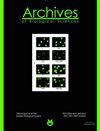Distribution of interstitial cells of Cajal and nerve fibers in rat stomach in streptozotocin-nicotinamide-induced diabetes mellitus
IF 0.8
4区 生物学
Q4 BIOLOGY
引用次数: 0
Abstract
Diabetic peristalsis disorders are common complications in diabetes mellitus type 2. Disturbance of interstitial cells of Cajal (ICC) caused by metabolic changes in diabetes could explain the symptoms of diabetic gastroenteropathy. Although heterogenous interstitial cell types represent only 5% of the cell population of the muscle layer in the gastrointestinal tract (GIT), they are important for conducting electrical signals and regulating muscle excitability. The aim of this study was to investigate the alterations of the myenteric and intramuscular ICCs in the gaster of rats with diabetes mellitus type 2 (DMT2), as well as determine their distribution in relation to smooth muscle cells and enteric nerve structures. Male Wistar rats were used and DT2 was induced by streptozotocin-nicotinamide (STZ-NA) application. The stomach specimens were exposed to type III transmembrane tyrosine kinase (c-KIT), neurofilament (NF-M) protein and desmin antibodies to investigate the ICC, enteric neurons and smooth muscle cells. Morphological changes of the cells were quantified by the numerical areal density of intramuscular ICC, the ICC score of myenteric ICC and the volume density of nerve fibers. In conclusion, a statistically significant decrease in the number of intramuscular ICC and myenteric ICC without nerve fiber loss were observed in all stomach regions in rats with STZ-NA-induced DMT2.链脲霉素-烟酰胺致糖尿病大鼠胃Cajal和神经纤维间质细胞的分布
糖尿病性肠蠕动障碍是2型糖尿病的常见并发症。糖尿病代谢变化引起的Cajal间质细胞(ICC)紊乱可以解释糖尿病性胃肠病的症状。尽管异质间质细胞类型仅占胃肠道肌层细胞群的5%,但它们对于传导电信号和调节肌肉兴奋性很重要。本研究旨在探讨2型糖尿病(DMT2)大鼠胃肌内和肌内ICCs的变化,并确定其在平滑肌细胞和肠神经结构中的分布。以雄性Wistar大鼠为研究对象,应用STZ-NA诱导DT2。采用III型跨膜酪氨酸激酶(c-KIT)、神经丝蛋白(NF-M)和desmin抗体检测胃标本的ICC、肠内神经元和平滑肌细胞。采用肌内ICC数值面密度、肌间ICC评分、神经纤维体积密度等方法定量观察细胞形态学变化。综上所述,stz - na诱导DMT2大鼠各胃区肌内ICC和肌内ICC数量均有统计学意义的减少,但未出现神经纤维损失。
本文章由计算机程序翻译,如有差异,请以英文原文为准。
求助全文
约1分钟内获得全文
求助全文
来源期刊
CiteScore
1.40
自引率
0.00%
发文量
25
审稿时长
3-8 weeks
期刊介绍:
The Archives of Biological Sciences is a multidisciplinary journal that covers original research in a wide range of subjects in life science, including biology, ecology, human biology and biomedical research.
The Archives of Biological Sciences features articles in genetics, botany and zoology (including higher and lower terrestrial and aquatic plants and animals, prokaryote biology, algology, mycology, entomology, etc.); biological systematics; evolution; biochemistry, molecular and cell biology, including all aspects of normal cell functioning, from embryonic to differentiated tissues and in different pathological states; physiology, including chronobiology, thermal biology, cryobiology; radiobiology; neurobiology; immunology, including human immunology; human biology, including the biological basis of specific human pathologies and disease management.

 求助内容:
求助内容: 应助结果提醒方式:
应助结果提醒方式:


